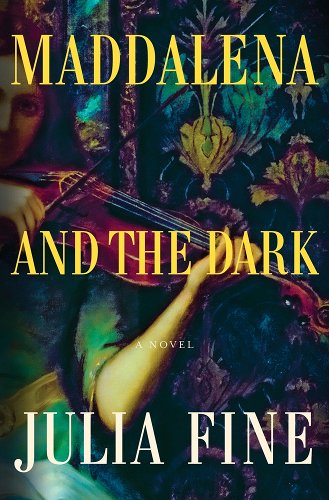[ad_1]
Julia Fine is back. I wouldn’t say she necessarily went anywhere – she’s steadily published novels since her debut in 2018 – but with her most recent, Maddalena and the Dark, she’s triumphantly returning to your bookshelves with her signature dark feminist speculative fiction. And it’s a masterpiece.
Set in 18th century Venice, Maddalena and the Dark follows two teenage girls studying music, falling in love (with each other?), and making increasingly dangerous sacrifices to a mystical creature in the waters of the canals. Luisa – timid, obedient, prudent – has lived her whole orphaned life at the Pietà, desiring only to be the best at violin and to join the illustrious orchestra with hopes of becoming the great Antonio Vivaldi’s protégé. Maddalena – clever, reckless, audacious – is new to the Pietà, sent there by her noble family to become more desirable for a suitor, and to overshadow the fact her mother has likely absconded with another man, bringing shame to the family name.
When the two girls meet, their singular desires are upended. They are drawn to each other as only two opposites can be, and soon they are connected by something ancient and powerful in the depths of the water. A silent gondola takes them to a lagoon where the girls make offerings in secret, and easy as that, they find themselves with more than they could have dreamed: a trust between one another, the promise of success, and a whole life ahead of them, together. But wagers with mystical creatures come with a price to pay, and eventually Maddalena and Luisa must face the violent consequences of their meddling.
If Olivia Rodrigo and Vivaldi had a musical baby, this book would sound like that. Full of dark, delicious desire on every page, this novel may be Fine’s best work yet. I was lucky enough to exchange emails with her about the rich history of Venice, big feelings of teenage girls, and how fairy tale elements helped shape the book.

Sara Cutaia
Let’s start off with something I’m sure is on everyone’s mind: what drew you to 1717 Venice? And, a follow up, how much research did you do to immerse yourself in the culture and time period? Because it feels richly authentic and tangible.
Julia Fine
I chose 18th century Venice specifically for the Ospedale della Pietà. For years I’d known that Vivaldi taught violin to, and wrote music for, female musicians, and the combination of gothic buildings and eerie lagoons and competitive teenage girls seemed almost too good to be true. Once I’d committed to that time period, I started finding parallels between the political situation in Venice in the early-to-mid 18th century, and what was happening to America right now: a one-dominant global power coming to terms with its new role, faced with decisions to either uphold the status quo or shake things up in a way that would be uncomfortable for the powerful in the short term, if better for future generations. I researched Venice for about a year before I even started writing–not just the 18th century, but the entire history of the Republic. I read biographies and histories and primary sources and theses, and of course listened to and read about the music being made. YouTube is an excellent source for getting up close and personal with professional musicians. I also traveled to Venice, which felt almost like a pilgrimage. The city is superficially very similar to what it would have been for Maddalena and Luisa, and it was easy to immerse myself in their lives. Although Santa Maria della Pietà, the church that was attached to the Ospedale, was remodeled in the mid-1700s, it still has the grates in the choir lofts, and a Vivaldi museum upstairs for those who know to ask.
Sara Cutaia
There’s a line I love early on in the book: “How does a friendship begin? A conversation. An affinity. A secret.” The book is so deliciously rich with the intimacy between Maddalena and Luisa, and I wondered how you first got the idea to link these two girls in this dark and dangerous way?
Julia Fine
I’m very interested in the type of early teenage girl friendships that seem to totally blur lines. That feeling of ‘do I love my friend so much I actually hate her? Do I want to tear her down, or help her up, or have sex with her, or cry to her, or be her?’ A lot of that is probably a reflection on/ projection of how teenage girls see themselves, but it’s also such a vivid, hormonal, high stakes time of life. You have such big feelings and so little experience of the world. You’re heavily impacted by your childhood traumas, but haven’t necessarily put the pieces together to understand what that means. These girls are drawn to each other, and they are living in a world that doesn’t give them language for what they’re experiencing, or outlets for what they feel.
Sara Cutaia
These pages vibrate with the melody and rhythm of an orchestra, both in the plot pacing and on the sentence level. How much did you think about music in relation to written storytelling while writing this novel?
Julia Fine
From the moment I decided to write about musicians, I knew I wanted the novel to pay tribute to classical music both in structure and prose. In orchestral music, different instruments take up the melody with variations, and I wanted the two narrators to mimic that experience. One girl will tell her version of the story, and then the other will step in with a slight difference in interpretation that recolors the scene for the reader. The accumulation of this dissonance ultimately sets off the third act of the book. I was also trying to mimic the rhythms of some of the Vivaldi pieces that inspired and are featured in the novel. I was thinking about speed and scale and movement.
Sara Cutaia
I loved the subtle fairytale elements in this book, the unnamed dark magic from the depths of the sea. I was enthralled by Maddalena’s parallel obsessions with this power and with Luisa, watching her infatuations grow in intensity. I’m curious how you saw something speculative like magic working alongside things so familiar, like female friendship, jealousy, and obsession?
Julia Fine
The rule that the women at the Pietà had to give up performing if they left the Ospedale was a real one, and it immediately had me thinking about “The Little Mermaid.” There’s also a fairytale element to the Festa della Sensa, when Venice marries the sea by throwing a wedding ring into the ocean. I wondered what was on the other side, who would be waiting and what would be bound. It seemed only natural that there would be some Faustian bargain, and that the messy realities of relationships and hormones and social politics would intrude on any wish the water granted.
Sara Cutaia
There’s a seductive string of suspense throughout the whole novel, which I found myself noticing as the point of view switched back and forth. Was that part of the reason you went with dueling narratives?
Julia Fine
Much of that decision came from the structures of classical music—that repetition with variation. But I’m also interested in how people can share experiences and interpret them so differently. Both girls are shaped by their respective histories, and as such have information that they choose to withhold from or share with each other. They’re best friends but they have these huge secrets, and I wanted the reader to have access to everything. The hope is that in sharing the narration, the two also share the reader’s empathy, even in the story’s darkest moments.
Sara Cutaia
We’ve talked before about your two previous books, and I saw topics explored again in this novel: motherhood (both Maddalena and Luisa have lost theirs), womanhood (their place in society, their roles as women), desire (wanting each other, music, fame, love, and feeling guilt for those wantings). I think it’s a mark of a very talented writer to revisit themes and continually find new ways to approach and examine them. What new ideas did you want to explore with these themes in Maddalena?
Julia Fine
Well, thank you! I’m always interested in women’s inner lives, specifically in eras when the access that we have feels incomplete. I want to read as much as I can from any historically underrepresented group, but as a writer I stick with what I think I can speak to authentically—in this case the tumultuous emotions of teen girlhood in a very prescriptive society. I think this book tackles wealth and social status in a way I hadn’t really in the others—the intersectionality of identity and how that impacts power. Maddalena has a lot stacked against her, but she also has money and lineage, and in the end that’s no small thing. There’s an eat or be eaten aspect to teen girls in patriarchal societies, and it’s a lot easier to eat when all your other basic needs are being met.

FICTION
Maddalena and the Dark
By Julia Fine
Flatiron Books
Published June 13, 2023

[ad_2]
Source link

